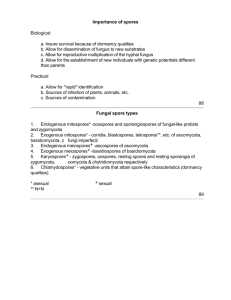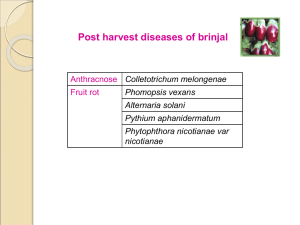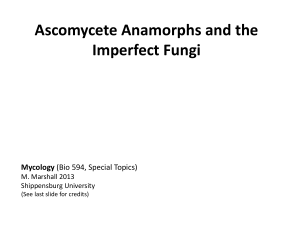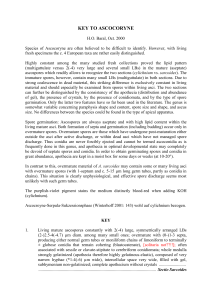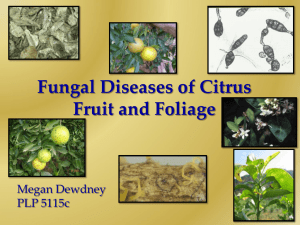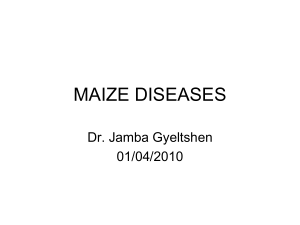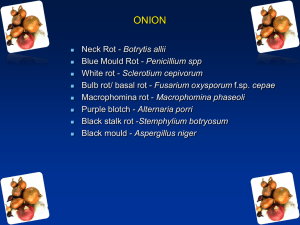Conidiogenous cell - University of Agriculture Faisalabad
advertisement
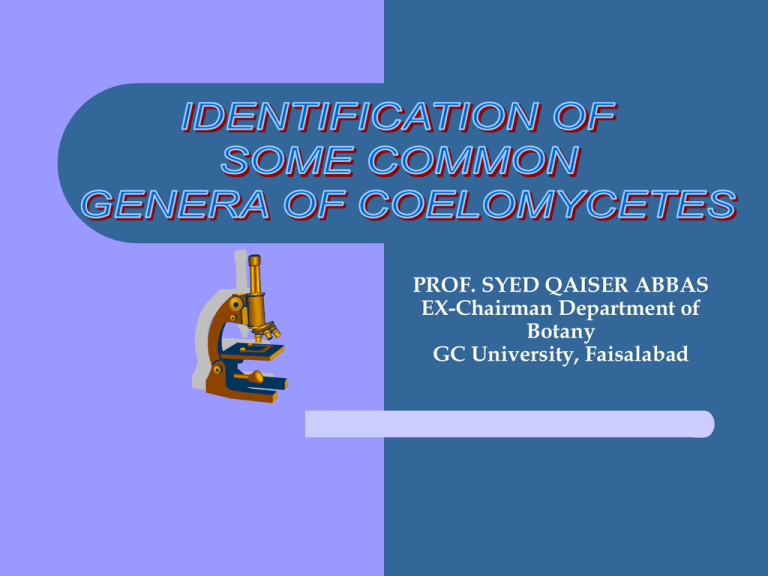
PROF. SYED QAISER ABBAS EX-Chairman Department of Botany GC University, Faisalabad Identification of Some Common Genera of Coelomycetes Basis of identification CONIDIOMATAL STRUCTURES CONIDIA & CONIDIOGENESIS CONIDIOMATAL STRUCTURES (Six variants morphological types) – Phoma-type (Conidiomata Pycnidial, dark colored, leathery to carbonaceous, stromatic or non-stromatic pycnidia generally with a circular ostiole) Zythia (Nectria)-type (Conidiomata Pycnidial as in Phomatype, but light colored, and sometimes waxy) – Leptostroma-type (Conidiomata shield-shaped) Discella-type (Conidiomata more or less cup shaped) Pycnothyrial Type (Conidiomata pycnothyrium) – Eustomata Type (Conidiomata Eustomatic, Multilocular of – – complex structure of different shapes) Types of Conidiomata Hyphal: Conidia are formed on hyphae. Sporodochial: Conidiophore aggregate in a manner that they formed a cushion-like structure. Synnemata: The conidiophores aggregate in a manner that they are forming a bundle of sticks-like structure. Acervulus: The conidiophores are formed on saucer-like structure. Pycnidium: The conidia and conidiophore are formed in closed unilocular body. Eustromata: The conidiomata are multilocular and conidia are formed inside the body. Conidiogenesis: A process of conidia formation. Three types(Hennbert and Sutton, 1994) Blastic: Thallic: (Septa formed first then conidia mature) Thalloblastic: (Intermediary between Blastic and Thallic (Conidia mature first then septa formation occurs) conidiogenesis, Conidiogenous cells slightly increase in shape and size then septa formation occur, afterward maturation of conidia occurs) Conidiogenesis: Conidia Formation in relation to wall Hologenous: Conidial wall formed by two layer of conidiogenous cells Enterogenous: Conidial wall formed by only inner wall of conidiogenous cells which forms the outer wall of the conidia and inner wall of conidia formed, from the conidial cell contents Endogenous: Conidial wall of conidia formed by cytoplasmic content of cell or structure where they are formed. Conidia Formation in relation to wall Process of Conidiogenesis (Involves Five Steps) 1:- Initiations: first step in conidiogenesis, enzymes involved in wall building become very active and according to conidial development pattern, apical wall building material or lateral wall building materials becoming available and increase in size and in shape become evident. 2:- Maturation: Conidia acquire their full shape and size. 3:- Delimitation: Conidia are separated by septa formation. However, this depends upon thallic, blastic or thalloblastic type of conidiogenesis when it has to be formed. Process of Conidiogenesis 4:- Seccession: Separation of conidia from conidiogenous cell. Schizolytic: Separation of conidia occurs by two pile septum in a way that conidia and conidiogenous cells both have half part of septum Rhexolytic: conidia separate from conidiogenous cells in a way that both part remain attached to conidia hence conidiogenous cell splits just below the septum, which separate conidia and conidiogenous cell. Process of Conidiogenesis 5:- Proliferation, or successive development of conidial loci Generally only a single conidium is produced at a locus, however, in many cases a number of conidia are produced simultaneously or successively at newly developing loci .The process is called proliferation and of three types. 1 Progressive proliferation: Length of conidiogenous cells increases. 2 Stationary proliferation: Length of conidiogenous cells does not increases. 3 Retrogressive proliferation Length of conidiogenous cells decreases. Process of Conidiogenesis Identification of Some Common Genera of Coelomycetes 1 Coniothyrium Cde. – – – – Conidiomata …………Pycnidial Conidiophore …………… Absent. Conidiogenous cell………Blastic,hologenous and progressive. Conidia………………… Unseptate,brown and not enclosed in a mucilaginous sheath. Coniothyrium Cde. Sphaeropsis Sacc. Conidiomata …………Pycnidial – – – Conidiophore ………… Absent Conidiogenous cell………Blastic,hologenous, non-proliferating but some time with one proliferation Conidia………………… Unseptate, brown to black not enclosed in a mucilaginous sheath. Sphaeropsis Sacc. Microsphaeropsis Hohn – – – – Conidiomata …………Pycnidial Conidiophore …………… Absent Conidiogenous cell……… Blastic, enterogenous and stationary Conidia……………………Unseptate, brown to black not enclosed in a mucilaginous sheath. Microsphaeropsis Hohn Avetteae Petrak & Syd. – – – – Conidiomata …………Pycnidial to eustromatic Conidiophore …………… Absent or rearly of 1-3 celled. Conidiogenous cell………Blastic, hologenous and progressive. Conidia…………………Unseptate, brown to black and enclosed in a mucilaginous sheath. Avetteae Petrak & Syd. Phoma Sacc. – – – – Conidiomata …………Pycnidial Conidiophore ……………Absent are rarely of one celled. Conidiogenous cell………Blastic, enterogenous and stationary Conidia…………………Unicellular hyaline and non enclosed in mucilagenous sheath Phoma Sacc Phyllosticta Desm. – – – – Conidiomata …………Pycnidial Conidiophore ……………Absent are rarely of one celled. Conidiogenous cell……Non proliferating and, some time proliferate enterogenous and stationarly Conidia…………………Unseptate, hyaline enclosed in mucilagenous sheath Phyllosticta Desm. Ascochyta Lib. – – – – Conidiomata …………Pycnidial Conidiophore ……………Absent Conidiogenous cell…… Enterogenous and stationary Conidia……………… Uniseptate and hyaline Ascochyta Lib. Diplodia Fr. – – – – Conidiomata ……… Pycnidial Conidiophore ………… Branched and septate about and unbranched cylindrical at the base Conidiogenous cell……Blastic, hologenous and non proliferating Conidia……………………1 septate, septa transverse and brown to black Diplodia Fr. Hendersonia Berk. – – – – Conidiomata …………Pycnidial Conidiophore …………… Absent are rarely of one celled. Conidiogenous cell……… Blastic, hologenous and prograssive. Conidia………………… Multiseptate, septa transverse and brown with out appendages Urohendersonia Speg. (Fig. 15) – – – – Conidiomata …………Pycnidial Conidiophore ……………Absent are rarely of one celled. Conidiogenous cell…… .Blastic, hologenous and prograssive. Conidia…………………Multiseptate, septa transvers and brown with one apical appendage Urohendersonia Speg. Seimatosporiopsis Sutton,Ghaffar & Abbas. – – – – Conidiomata ……… Pycnidial to eustromatic Conidiophore ………… Absent Conidiogenous cell…… Blastic, hologenous and prograssive. Conidia………………… Multiseptate with 3-4 transvers septa and brown with one apical and basal appendage Seimatosporiopsis Sutton,Ghaffar & Abbas. Camarosporium Schulz. – – – – Conidiomata …………Pycnidial Conidiophore ……………Absent Conidiogenous cell…… Blastic, hologenous and prograssive. Conidia………………… Multiseptate, muriform, brown Camarosporium Schulz.
